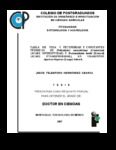Tablas de vida y fecundidad y constantes térmicas de Pediculaster mesem brinae (Canestrini) (Acari: Siteroptidae) y Brennandania lambi (Kreczal), (Acari: Pygmephoridae), en champiñon Agaricus bisporus (Lange) Imbach
Abstract
xvii
Se realizó un estudio de tablas de vida y fecundidad y constantes térmicas
de Pediculaster mesembrinae (Canestrini) (Acari: Siteroptidae) y Brennandania
lambi (Kreczal) (Acari: Pygmephoridae) en condiciones controladas (15, 20, 25 y
30 °C, humedad relativa de 60 ± 5 %) con cohortes de 40 ácaros confinados
individualmente en dispositivos de observación (DO). Como sustrato y alimento se
utilizó paja fermentada (composta) inoculada con esporas de Tricoderma
harzianum Rifai, para P. mesembrinae; mientras que para B. lambi se utilizó
micelio de Agaricus bisporus (Lange) Imbach. Para la construcción de tablas de
vida se partió de huevecillos con una edad promedio de 5 horas, observándolos
cada 12 horas hasta que el último individuo murió. Se definieron las etapas del
ciclo de vida, para esto se obtuvieron las curvas de supervivencia (lx) y fecundidad
(mx) y se estimaron los parámetros poblacionales y las constantes térmicas para
cada especie. El ciclo de vida de P. mesembrinae y B. lambi incluyeron los
estadios de huevo, larva, larva quiescente o ninfocrisálida y adulto, sólo se
observaron hembras en dos poblaciones. La duración del ciclo de vida y la
longevidad total tuvieron una relación inversa (lineal) con la temperatura. Los
valores de la tasa intrínseca de incremento (rm) para P. mesembrinae fueron de
0.146, 0.132, 0.170 y 0.204., mientras que los valores rm para B. lambi fueron
0.156, 0.167, 0.198 y 0.295 a temperaturas de (15, 20, 25 y 30 °C),
respectivamente. Las tasas de desarrollo tuvieron una relación lineal directa con la
temperatura, mientras que las temperaturas umbral oscilaron entre 0.17 y 1.03 °C
para P. mesembrinae y de 6.01 a 6.74 °C para B. lambi. El desarrollo de huevo-
adulto requirió de 190.58 grados día para P. mesembrinae y 214 grados día para
B. lambi_________ xix
Life and fecundity table studies on Pediculaster mesembrinae (Canestrini)
(Acari: Siteroptidae) and Brennandania lambi (Kreczal) (Acari: Pygmephoridae)
were conducted under controlled conditions (15, 20, 25 and 30°C, 60 ± 5 %)
relative humidity, using cohorts of 40 individually confined mites in observation
devices (DO). Fermented wheat straw (compost) previously inoculated with
Trichoderma harzianum Rifai and Agaricus bisporus (Lange) Imbach spores was
used as substrate and food source for P. mesembrinae and B. lambi, respectively.
The study started with mite eggs approximately 5 h old, which were observed
every 12 hours until the last individual was dead, The life cycle stages were
defined for which survival (lx) and reproduction (mx) curves were obtained and
population parameters and thermic constants were estimated for each species.
The life cycle of P. mesembrinae and B. lambi included the stages of egg, larva,
quiescent larva or nymphocrysalis, and adult; only females were observed in two
populations. Duration of the life cycle of P. mesembrinae as well as total longevity
showed an inverse (linear) relationship with temperature. Values of (rm) (intrinsic
rate of increase) for P. mesembrinae were 0.146, 0.132, 0.170 and 0.204, for 15,
20, 25 and 30°C, respectively. For B. lambi were 0.156, 0.167, 0.198 and 0.295 for
the some temperatures. Developmental rates had a direct and linear relationship
with temperature; and threshold temperatures ranged between 0.17 and 1.03 °C
for P. mesembrinae and between 6.01 and 6,74 °C for B. lambi. Development from
egg to adult required 190.58 degree days for P. mesembrinae and 214 degree day
for B. lambi.
Collections
- Tesis MC, MT, MP y DC [284]


